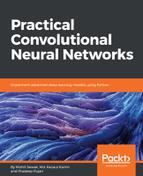In the 'Why is object detection much more challenging than image classification?' section, we used a non-CNN method to draw region proposals and CNN for classification, and we realized that this is not going to work well because the regions generated and fed into CNN were not optimal. R-CNN or regions with CNN features, as the name suggests, flips that example completely and use CNN to generate features that are classified using a (non-CNN) technique called SVM (Support Vector Machines)
R-CNN uses the sliding window method (much like we discussed earlier, taking some L x W and stride) to generate around 2,000 regions of interest, and then it converts them into features for classification using CNN. Remember what we discussed in the transfer learning chapter—the last flattened layer (before the classification or softmax layer) can be extracted to transfer learning from models trained on generalistic data, and further train them (often requiring much less data as compared to a model with similar performance that has been trained from scratch using domain-specific data) to model domain-specific models. R-CNNs also use a similar mechanism to improve their effectiveness on specific object detection:

Another place we stumbled at was the differing scales (and location) of the regions of interest, recognition using region. This is what is called the localization challenge; it is solved in R-CNN by using a varying range of receptive fields, starting from as high a region with 195 x 195 pixels and 32 x 32 strides, to lesser downwards.
Wait a minute! Does that ring a bell? We said that we will use CNN to generate features from this region, but CNN uses a constant-size input to produce a fixed-size flattened layer. We do require fixed-size features (flattened vector size) as input to our SVMs, but here the input region size is changing. So how does that work? R-CNN uses a popular technique called Affine Image Warping to compute a fixed-size CNN input from each region proposal, regardless of the region's shape.
Besides the challenges that we have covered, there exists another challenge that is worth mentioning. The candidate regions that we generated in the first step (on which we performed classification in the second step) were not very accurate, or they were lacking tight boundaries around the object identified. So we include a third stage in this method, which improves the accuracy of the bounding boxes by running a regression function (called bounding-box regressors) to identify the boundaries of separation.
R-CNN proved to be very successful when compared to the earlier end-to-end non-CNN approaches. But it uses CNN only for converting regions to features. As we understand, CNNs are very powerful for image classifications as well, but because our CNN will work only on input region images and not on flattened region features, we cannot use it here directly. In the next section, we will see how to overcome this obstacle.
